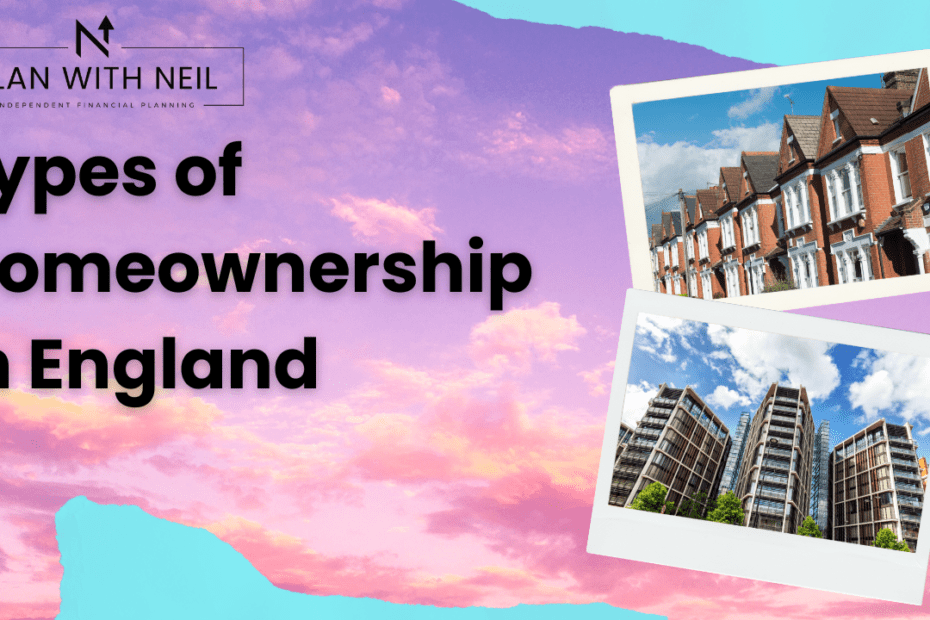When buying a house in England, there are a few different types of home ownership and all of these terms can get a bit confusing, especially for first time home buyers. With this blog post we are going to break them down in a simple and easy to understand way.
Sole vs Joint Home Ownership
These two terms are pretty self explanatory. Sole property ownership is when only one person’s name is on the title. This can work well in situations like if a person is single and buying a home on their own or if someone is in a less serious relationship and they are the breadwinner and paying the mortgage so they don’t want to have their partner or anyone else on the title. If only one person in the relationship is on the title and they pass away, the home doesn’t automatically go to their partner unless they’re named in the will. If the couple are married or in a civil partnership, then the spouse that isn’t on the title still has matrimonial home rights. You can change from a sole ownership to a joint ownership, but there is a cost.
There are two types of joint property ownership: joint tenants and tenants in common. Joint tenants own the home equally. If one of the joint tenants dies, the property automatically goes to the other owners, regardless of what the will says. Another type of joint property ownership is tenants in common, where each owner owns a certain share of the property, but it doesn’t automatically go to them if one person dies. You decide who to pass on your share of the property in your will. There is no fee to change between these types of ownership.
Leasehold
In a leasehold, you only own the property for a certain period of time. In other words, you are buying a long lease from a landlord, who is the freehold owner. Leaseholds can be as short as 80 years or less or up to 999 years. On top of paying your mortgage, you will have to pay ground rent and leasehold charges. Ground rent can increase over time. Once the leasehold runs out, you either have to pay to extend it or the property goes back to the landlord.
This type of home ownership doesn’t seem great because it seems like the worst parts of renting and owning combined in one. The reason people buy leasehold properties is mainly because they’re cheaper than freehold and they like the location of the property. Location is key in real estate. People want to be near work, school, shops, parks, and other amenities. Flats are often leasehold and some people prefer to live in flats. Flats are lower maintenance and cheaper to live in. They’re also appealing to investors looking to buy buy-to-let properties.
Shared Ownership
Buying a house is expensive. You have to have enough money for a deposit and be able to afford the mortgage payments. How can someone get on the property ladder without having to rent for ages? That’s where shared ownership comes in. These are often new build homes, but some are existing homes sold through a shared ownership resale scheme. These are a type of leasehold ownership.
Basically, you buy a share of the house from 10-75% and you pay the mortgage on that and you pay rent on the remaining portion the housing association owns. Like leaseholds, you will have to pay ground rent and monthly service charges. Over time, you can staircase and buy out the other shares of the house and eventually own it 100%. You might even be able to buy the leasehold in some situations. However, you can only buy a shared ownership property if you’re a first time buyer, existing shared ownership homeowner, or former homeowner who can’t afford to buy now. You also cannot make more than £80k/year (or £90k/year if you live in London).
Commonhold
These are basically freehold flats. Commonholds are indefinite in time and you actually own your flat and the residents have a say in how the building is maintained and managed. Flats have common areas like the external parts of the building, hallways, foyers, and amenities like gyms, playgrounds, and pools. This style of home ownership is similar to condominiums in the United States and Canada. Commonholds are a relatively new scheme since they were introduced in 2002. If you own a leasehold in a shared building it is possible to convert ownership into a commonhold if all of the other leaseholders and the freeholder agree.
Freehold
With freehold, you own both the building and the land it’s on indefinitely. It’s truly yours until you decide to sell it. Obviously with it being freehold, it will be more expensive than a leasehold, but it’s worth it for that extra peace of mind. You have freedom to do what you want with your property. Because you don’t have ground rent to pay, once you own the home free and clear, all you have to worry about is council tax, like anyone else. If you want to pass down your home to your children, you can do it without worrying about a lease expiring.
To book your free one hour discovery meeting with Neil, click here.
